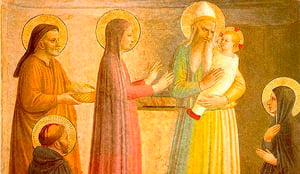 Feast of the Presentation of the Lord
Feast of the Presentation of the Lord
Scripture: Lectionary 524. Presentation of the Lord. Malachai 3:1-4, Psalm 24:7-10; Hebrews 2:14-18; Luke 2:22-40
In the Eastern Churches (Greek and Orthodox as well as Byzantine Churches) this beautiful feast is called “The Meeting” (Hypapante, in Greek). In fact, in my hometown, there is a Greek Orthodox Church that has the name Hypapante. What an appropriate name for the meeting of a holy family (Mary, Joseph, and Jesus), a sacred and holy place, the Temple of Jerusalem, and two holy prophetic persons, Simeon and Anna. The all meet in the Temple and Jesus is the person upon whom they are looking and loving for the ritual of purification forty days after the birth of the child Jesus. In a sense, it is Luke’s theological overture for the coming chapters of his great literary masterpiece.
The mother holds Jesus, then Simeon receives him in his arms and gives us the perfect night prayer for the whole Church—His “Nunc Dimittis”. We also have a rich tradition of special sermons and homilies on the feast done by some of the Eastern Fathers of the Church, notably, are those of Hesychius of Jerusalem (d. after 451). He has three homilies on the feast of the Meeting or Presentation of the Child Jesus in the Temple. (see an excellent summary in Theotokos written by Michael O’Carroll in A Theological Encyclopedia of the Blessed Virgin Mary, pp.169-171).
Luke is the only Evangelist who gives us a narrative of this event in the early life of the child Jesus. Central to this passage is the prophetic and holy proclamation of Simeon who addresses the Lord God and also the mother of Jesus in what he says. We do well to pray for our night prayer this famous prayer of Compline which the Church prays every evening:
“Now, Master, you can let your servant go in peace, (Nunc Dimittis), just as you promised; because my eyes have seen the salvation which you have prepared for all the nations to see: a light to enlighten the pagans, and the glory of your people Israel.” Simeon will also speak of the sword of sorrow that will pierce the heart of Mary: “This child is destined to be the downfall and the rise of many in Israel, a sign that will be opposed—and you yourself shall be pierced with a sword—so that the thoughts of many hearts may be laid bare.”
Another holy person then comes on the scene, Anna, who is eighty-four years of age, she praises God for who she sees in the arms of Simeon and speaks of the role of the child in the redemption of all peoples.
Tonight, before retiring, we may wish to pray the prophetic prayer of Simeon. We may end with the words of the Gospel speaking of how the child does grow in wisdom and grace before God and peoples. Amen.
Copyright 2013 Fr. Bertrand Buby, S.M.
About the Author

Lisa M. Hendey
Lisa M. Hendey is the founder of CatholicMom.com, a bestselling author and an international speaker. A frequent radio and television guest, Hendey travels internationally giving workshops on faith, family, and communications. Visit Lisa at LisaHendey.com or on social media @LisaHendey for information on her speaking schedule or to invite her to visit your group, parish, school or organization. Visit Lisa's author page on Amazon.com.


.png?width=1806&height=731&name=CatholicMom_hcfm_logo1_pos_871c_2728c%20(002).png)
Comments